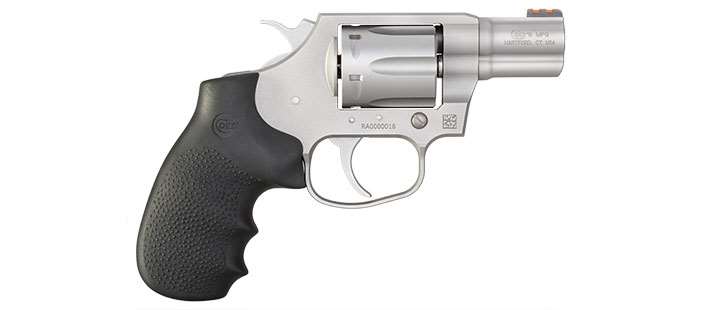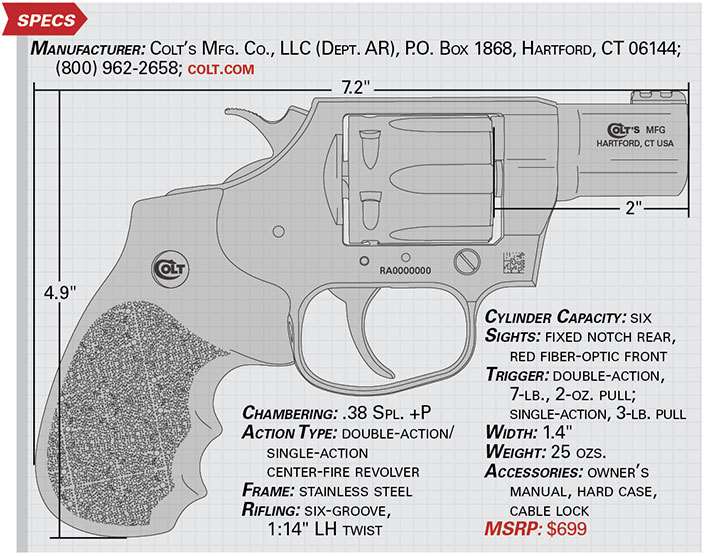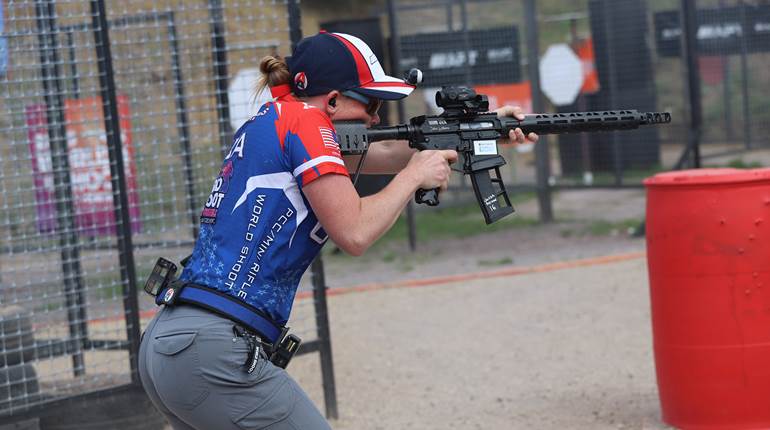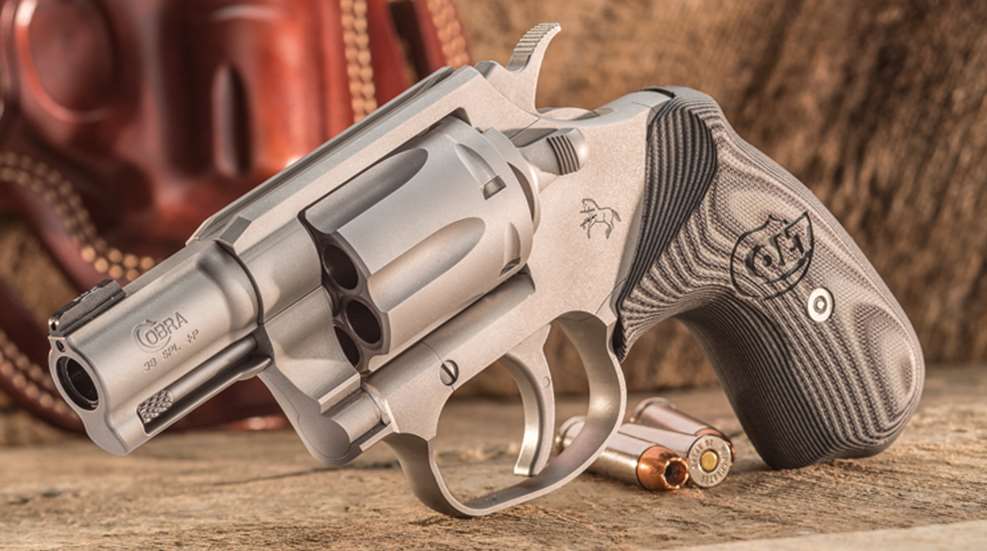
The .38 Spl. Cobra is a sideplate gun that drew inspiration from the last double-action Colt snubbies made—the SF-VIs and DS-IIs. Housing a dual leaf spring, the Cobra’s frame has been re-engineered to allow a more inline trigger stroke. Too, the trigger guard has been enlarged.
It is quite simply the stuff of legend. The young seaman watched the ship’s wheel as it indexed before the shaft that supported it. It was—and is—the nature of a ship’s wheel to come back around to exactly the same spot, and Samuel Colt’s inventive mind studied this simple geometric principle with a view toward exploiting it. Eventually, he devised a firearm using a cylinder with five chambers that aligned sequentially with the gun’s barrel. Using the then-new percussion caps to ignite each chamber’s charge of blackpowder in turn, Colt created a style of handgun that dominated battlefields for decades. Under his rampant Colt emblem, he made his first guns in Paterson, N.J., moved eventually to Hartford, Conn., and founded a company that became a legend in American industry. It started with the Paterson Colts in 1836 and continued until the last Pythons were made just over a decade ago. I cannot overstate the place of the Colt service revolver in the scheme of things. Indeed, there were many years when the word “Colt” was synonymous with revolver—the firm made little else.
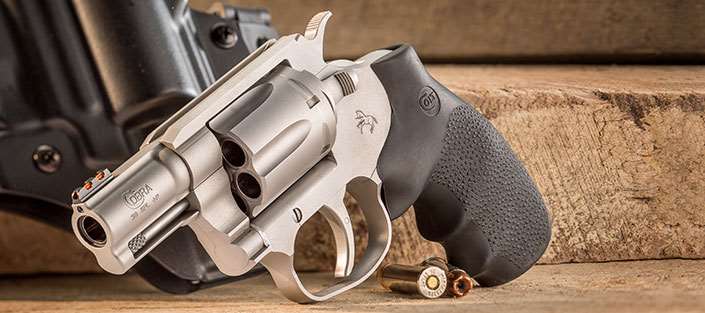
That situation has changed, and here I find myself beginning an article on a brand-new double-action/single-action (DA/SA) Colt revolver that coincidentally goes by the name of one of the serpent classics—the Cobra. We’ll get to the particulars and specifics of the new handgun, but we need to first put it in its proper context. I entered the police service in 1969, a time when 99.9 percent of all policemen holstered a revolver when they went to work. The first few departments tried semi-automatics at about that time. Ten years later, it was about fifty-fifty between service revolvers and the then-new, high-capacity (as in more than six) semi-automatic pistols. Another decade passed, and the service revolver virtually disappeared.
When revolvers came small, medium and large, Colt made them in all three sizes, as did Smith & Wesson. Most of the everyday police Colts were built on the small or medium frames. When they ceased—rightly or wrongly—to sell in quantity, the once-popular revolvers were no longer valuable to the product line. As law enforcement tires of a gun or cartridge, the civilian market follows suit. All of the legendary classics—Pythons, Troopers, Detective Specials, Diamondbacks and Cobras—were discontinued. They had come into existence at a time when the labor of trained gunmakers was far less costly than in the 1970s and ’80s. That was also a time when the market for those gorgeous old (expensive) wheelguns had been usurped by polymer-frame semi-automatics with detachable box magazines.

Of all the types of revolvers, the one that persists in the modern American shooter’s esteem is the small, short, light, defensive carry gun—usually a 2" .38 Spl./.357 Mag. All the major makers offer such models. Therefore, when new management at Colt opened the door to re-enter the market with a revolver, it chose a design that had the broadest potential appeal. The gun was many months in development and was finally unveiled at a gunwriters’ confidential seminar held at Gunsite in November of 2016. Other Colt products were on display, but the lion’s share of the attention fell on a stainless steel, six-shot .38 that read “Cobra” on the left side of the barrel.
A bit of history is in order here. True wheelgun fans are likely to recall that Colt made the first lightweight (aluminum-frame) revolver in 1950, calling it the Cobra. Essentially, the gun was a version of the company’s durable D-frame Detective Special, differing only in the light frame. With fixed sights, this frame was also used for the Police Positive Special. Tens of thousands of D-frame Colts were made, sold and widely respected. The newest Colt revolver, though, while the same in name, is completely re-designed and made almost entirely of stainless steel. It is true that there is a superficial resemblance in the lines of the frame and hammer. I was even able to use original D-frame Colt inserts in the Ransom Rest for machine rest testing. The butt is therefore shaped the same. One of the few mechanical points that the two guns have in common is a two-leaf mainspring. But even before we examine the new gun further, we need to understand why it is made the way it is made. Colt designed and built DA/SA revolvers as far back as the 1870s, but it was the late 1880s before it devised the first modern gun with a swing-out cylinder. They were made then in the way that made sense for the time: hydropower came from the Connecticut River just outside the front door of the plant, and there was a lot of shaping and fitting done by skilled human hands. The various models were designed to be made in this way, and, even by the end of the Python era, there was a lot of hand-fitting still going on.
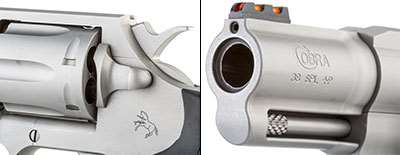
Guns simply can’t be made that way anymore and be cost-effective. The Cobra was designed from the ground up to be manufactured—literally assembled—as opposed to fitted. This is not to suggest that there are shortcuts taken or compromises made, it is just a reflection of the new era of firearm manufacturing in which we live. The Cobra is a quality firearm made with a combination of forgings and metal injection-molded parts. Put it this way—Sam Colt beat everybody else in the revolver business by using the best and most economical methods available. The company bearing his name now does the same.
Looking at the particulars, the Cobra is a 25-oz. revolver that boxes 7.2" by 4.9" by 1.4". It has a 2" barrel rifled with a six-groove, left-hand twist that makes a full turn in 14". This is the traditional recipe at Colt, and represents one of the fastest barrel twist rates in the revolver business. The stainless-steel cylinder, which turns clockwise, has six chambers that will accommodate any .38 Spl. load, regular or +P. It is released by pulling backward on a latch that is rounded in the traditional Colt style. The rear sight is a 1/8" notch milled into the rear corner of the topstrap. Out front, the sample revolver had an easily replaceable, red fiber-optic pipe in a post. Colt advised that a luminous night sight and possibly a plain black post might become available.
The actual shape of the Cobra is sort of a modernized version of the classic Colt DA/SA revolver. One of the most criticized points in that system is the exposed ejector rod at the front of the cylinder. It is fairly easy to bend this part, and, when you do, the solution is almost always a new rod—it is almost impossible to straighten one. To prevent this, Colt equips the Cobra with an under-barrel lug that shrouds the ejector rod from harm.

Also note the shape of the hammer and trigger, which are also very much like those of the older guns. One difference in shape is readily apparent. The old guns had trigger guards that were a bit on the small side, particularly when winter weather drives your hands into gloves. On this new Colt DA/SA revolver, the trigger guard is enlarged forward, toward the muzzle end of the gun. In addition to resolving the winter glove issue, it affords speedier access to the trigger while under duress. Further emphasizing improved handling and manufacturing, Colt paid close attention to the gun’s barrel. At the point where the barrel meets the receiver or frame, there is a convex boss to the barrel shape. If left off, this would make the gun harder to re-holster. It would also make the gun a bit blocky and awkward in appearance.
As it comes from the typical blue, plastic box, the Cobra wears the very effective Hogue, overmolded-rubber, one-piece grip. The finger-grooved and pebble-surfaced unit was designed and developed by the California company founded by LAPD pistolero Guy Hogue. This has been a successful unit for many years. To remove for cleaning, the shooter withdraws a screw from the bottom of the butt and pulls the rubber grip down and off the gun. Note that the screw goes into a metal stirrup that fits loosely on the frame. Since the shape of the revolver’s butt was close enough to that of the original D-frame Colt, it is possible that custom grips of other makes and types might be made to work on today’s Cobra. It is at least theoretically possible to equip the gun with something more compact and concealable. A prototype G10 grip also looks—and feels—very good.
And that brings us to a point where we can examine the performance of the Cobra. At the range, I ran the Cobra through the formal evaluation at 25 yds. from a Ransom Rest. Accuracy was in the 2½" range for five-shot groups with several kinds of modern ammunition. The results are tabulated nearby.
I spent a lot more time shooting pairs and learning to handle the Cobra all over again. The new gun’s action is its salient feature, which is as it should be since a defensive revolver will most likely be fired in double-action mode and rapidly. The specifications for the gun state that the trigger pull runs from 7 to 9 lbs. Most contemporary revolvers are no less than 10 and may run as high as 12 lbs. I have handled about seven or eight examples of Colt’s new gun and fired three. I think their pull is closer to the lower figure of 7 lbs. When required, the Cobra can give you a clean, non-creeping, single-action pull of just about 3 lbs. Much of the reason stems from the development and positioning of that twin leaf mainspring.
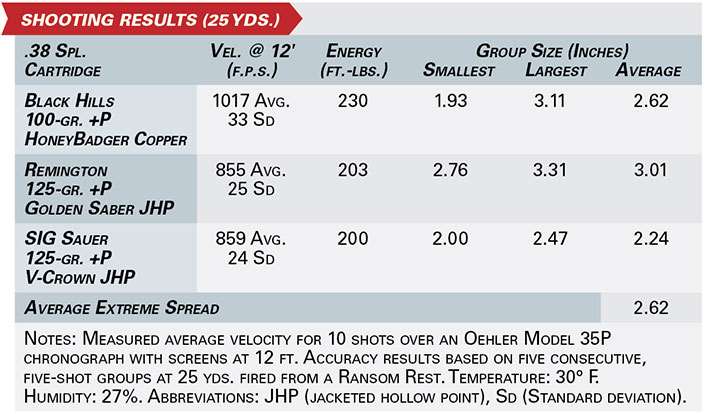
Despite its fine action, some of today’s shooters are going to have problems dealing with the Cobra’s trigger because they are used to double-action-only (DAO) striker-fired systems on modern pistols that encourage running through fast pairs by pressing the trigger at the earliest possible moment after it resets. Since the DAO semi-automatic pistol trigger either partially or entirely cocks the gun’s striker and then releases it (two actions), it is possible to shorten the trigger arc and allow for a fast reset. Pulling a double-action revolver’s trigger not only cocks the gun but also simultaneously turns the cylinder and, finally, releases the hammer. You must stroke the Cobra trigger all the way through a rather long arc to ensure the entire sequence occurs. I mention this because I have already witnessed several handgunners short-stroking the Cobra trigger on a second shot and looking puzzled as to why they didn’t get the expected “boom.” Regardless, I would not hesitate to go armed with this new sixgun. The smooth, continuous sweep of its excellent double-action pull exhibits nothing in the way of stacking or staging. It takes no small feat of engineering to design a gun with that level of performance.
There is great potential in this newest serpent revolver. Colt is being close-mouthed about Cobra variations, but we may see other chamberings, barrel lengths, sights, grips and the like. For now though, it serves as tangible proof that Colt has re-discovered the wheel.
